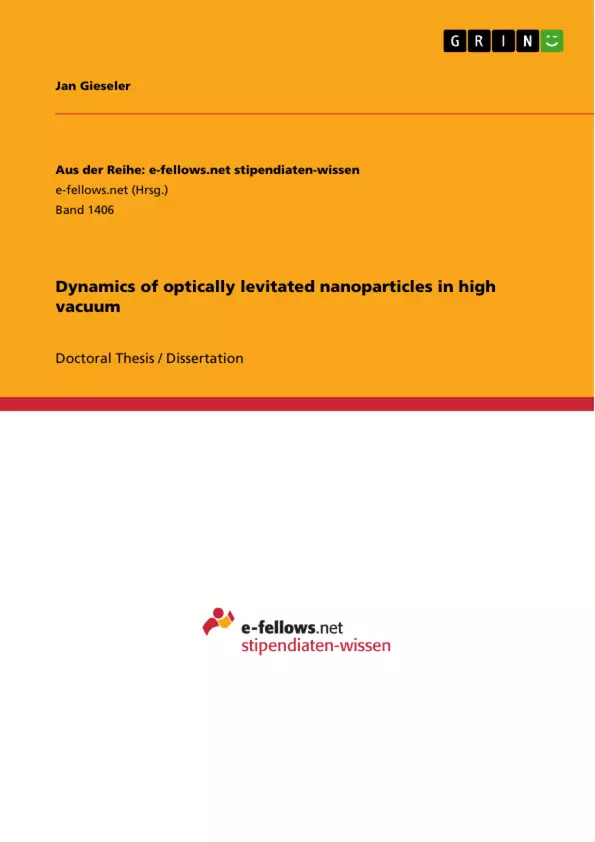The present thesis investigates the dynamics of optically levitated particles in high vacuum. A levitated nanoparticle in high vacuum constitutes a nanomechanical resonator featuring a small mass and a ultra-high quality factor - significantly higher than that of fabricated nanomechanical resonators, which are approaching fundamental limits of dissipation.
The combination of small mass and high quality factor allows for sensing of feeble exotic forces, including gravitational forces, and quantum state preparation. Investigating the quantum behavior of a nanomechanical system and testing the predictions of quantum theory on meso- to macroscopic scales, addresses one of the outstanding challenges of modern physics and will provide answers to fundamental questions on our understanding of the world.
The scope of the thesis ranges from a detailed description of the experimental apparatus and proof-of-principle experiments (parametric feedback cooling) to the first observation of phenomena owing to the unique parameters of this novel optomechanical system (thermal nonlinearities). Aside from optomechanics and optical trapping, the topics covered include the dynamics of complex (nonlinear) systems and the experimental and theoretical study of fluctuation theorems, the latter playing a pivotal role in statistical physics.
Optically trapped nanoparticles are just beginning to emerge as a new class of optomechanical systems. Owing to their unique mechanical properties, there is clearly a vast and untapped potential for further research. Primary examples of how levitated particles in high vacuum can impact other fields and inspire new research avenues have been the first observation of thermal nonlinearities in a mechanical oscillator and the study of fluctuation relations with a high-Q nanomechanical resonator. Based on recent progress in the field, a plethora of fundamental research opportunities and novel applications are expected to emerge as this still young field matures.
Inhaltsverzeichnis (Table of Contents)
- Introduction
- Motivation
- Overview and state of the art
- Optomechanics and optical trapping
- Complex systems
- Statistical physics
- Experimental Setup
- Optical setup
- Overview of the optical setup
- Detector signal
- Homodyne measurement
- Heterodyne measurement
- Feedback Electronics
- Bandpass filter
- Variable gain amplifier
- Phase shifter
- Frequency doubler
- Adder
- Particle Loading
- Pulsed optical forces
- Piezo approach
- Nebuliser
- Vacuum system
- Towards ultra-high vacuum
- Conclusion
- Optical setup
- Theory of Optical Tweezers
- Introduction
- Optical fields of a tightly focused beam
- Forces in the Gaussian approximation
- Derivation of optical forces
- Discussion
- Optical potential
- Conclusions
- Parametric Feedback Cooling
- Introduction
- Description of the experiment
- Particle dynamics
- Parametric feedback
- Theory of parametric feedback cooling
- Equations of motion
- Stochastic differential equation for the energy
- Energy distribution
- Effective temperature
- Experimental results
- Power dependence of trap stiffness
- Pressure dependence of damping coefficient
- Effective temperature
- Towards the ground state
- The standard quantum limit
- Recoil heating
- Detector bandwidth
- Conclusion
- Dynamics of a parametrically driven levitated particle
- Introduction
- Theoretical background
- Equation of motion
- Overview of modulation parameter space
- Secular perturbation theory
- Steady state solution
- Dynamics below threshold (linear regime)
- Injection locking
- Linear instability
- Frequency pulling
- Off-resonant modulation (low frequency)
- Dynamics above threshold (nonlinear regime)
- Nonlinear frequency shift
- Nonlinear instability
- Modulation frequency sweeps
- Modulation depth sweeps
- Relative phase between particle and external modulation
- Nonlinear mode coupling
- Sidebands
- Conclusions
- Thermal nonlinearities in a nanomechanical oscillator
- Introduction
- Description of the experiment
- Origin of nonlinear frequency shift
- Nonlinear spectra
- Experimental results
- Frequency and energy correlations
- Pressure dependence of frequency fluctuations
- Frequency stabilization by feedback cooling
- Conclusion
Zielsetzung und Themenschwerpunkte (Objectives and Key Themes)
This dissertation investigates the dynamics of optically levitated nanoparticles in high vacuum. The primary objective is to explore the potential of these systems for fundamental research in statistical physics, quantum mechanics, and optomechanics. The work focuses on using optical tweezers to trap and manipulate nanoparticles, studying their motion and interactions with the surrounding environment.
- Optical trapping and manipulation of nanoparticles
- Parametric feedback cooling and its application to achieve ground state cooling
- Nonlinear dynamics of levitated nanoparticles driven by external forces
- Thermal nonlinearities in nanomechanical oscillators
- Exploring the potential of levitated nanoparticles for fundamental research in various fields
Zusammenfassung der Kapitel (Chapter Summaries)
- Introduction: This chapter provides an overview of the motivation for studying optically levitated nanoparticles and the state of the art in optomechanics, complex systems, and statistical physics. It outlines the key research questions addressed in the dissertation.
- Experimental Setup: This chapter details the experimental setup used to trap and manipulate nanoparticles, including the optical setup, feedback electronics, particle loading techniques, and vacuum system. It describes the different measurement techniques employed.
- Theory of Optical Tweezers: This chapter presents the theoretical framework for understanding the interaction between light and nanoparticles, including the optical forces and potential experienced by the particle. It provides a theoretical foundation for the experimental observations.
- Parametric Feedback Cooling: This chapter explores the concept of parametric feedback cooling, a technique used to reduce the thermal motion of the trapped nanoparticle. It presents the theoretical model and experimental results demonstrating the effectiveness of this method.
- Dynamics of a parametrically driven levitated particle: This chapter investigates the dynamics of a levitated nanoparticle driven by an external force. It analyzes the linear and nonlinear regimes of motion, exploring phenomena such as injection locking, instability, and frequency pulling.
- Thermal nonlinearities in a nanomechanical oscillator: This chapter examines the thermal nonlinearities that arise in the dynamics of the levitated nanoparticle. It discusses the origin of these nonlinearities and their impact on the system's behavior.
Schlüsselwörter (Keywords)
Optically levitated nanoparticles, optical tweezers, optomechanics, parametric feedback cooling, ground state cooling, nonlinear dynamics, thermal nonlinearities, nanomechanical oscillators, statistical physics, quantum mechanics.
- Citar trabajo
- Jan Gieseler (Autor), 2014, Dynamics of optically levitated nanoparticles in high vacuum, Múnich, GRIN Verlag, https://www.grin.com/document/300442



